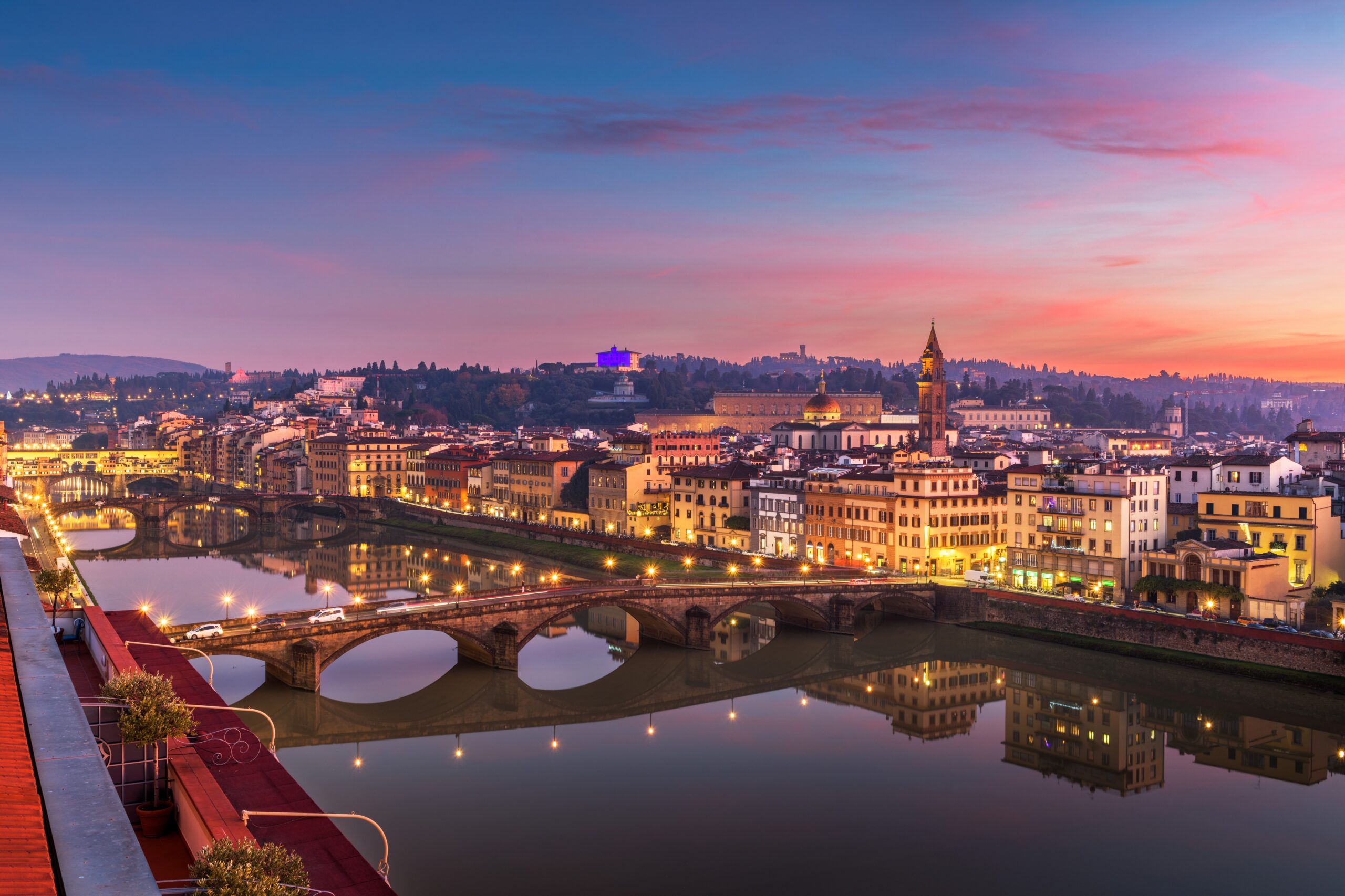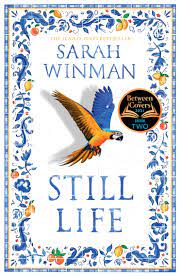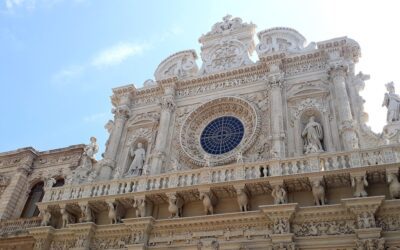Last updated on May 13th, 2024
Featured image: Florence and the Arno River, which flooded in 1966 causing devastation | Photo from Envato by SeanPavone
“Still Life” evokes the rich sensory palette of Florence
by Sally Jane Smith, Book Club Co-Host
It was a hot September afternoon when I stepped onto the station platform at Firenze Santa Maria Novella in 2013. We were on our way from Cinque Terre to Venice, with just four hours in Florence between one train and the next. We each had our own idea of how best to spend this time. My friend packed her aching feet onto a hop-on-hop-off tour bus to see as many iconic sites as possible. My own feet ached to tread the sunbaked stones of the city, and I set off on foot with my Lonely Planet – the Baedeker of my generation – in my hand.
Sarah Winman’s Still Life is set primarily in the Tuscan town I remember from that precious afternoon. In my mind, it’s a town that tastes of burnt umber and smells like terracotta – even though I’ve never tasted the pigment, and I’m not sure that terracotta actually has a smell. It is a city shaped by its river, bathed in a warm glow of light and saturated in artistic expression. The sensory palette of Florence has inspired countless creatives through the centuries – painters, sculptors, architects, musicians, writers, and more – in their attempts to capture its complexity. Everywhere you look, it feels as if art is gazing back at you.
Winman’s novel is aptly named, as it is itself a work of art. It portrays a life both still, in every sense of the word, and always progressing – through time, through the complexity of human relationships, through the personal and global challenges faced by its rich cast of characters. Even the protagonist’s vocation as a globe-maker can be read as a metaphor for the remaking of a world as the characters rebuild their lives after war, their homes after natural disaster, and their sense of self-worth as they reclaim or redeem their own flawed pasts. A steady ray of hope – and flashes of wonderful humour – shines through the narrative from beginning to end.
Still Life travels through four decades, and Winman displays exceptional skill in capturing the zeitgeist of Western Europe during this period. Instead of forcing a list of the era’s defining moments onto the page, she explores her characters’ responses to the events of the time. We get to see deep into some very vulnerable souls as we follow an extraordinary family of people who, for the most part, are bound by unconditional love rather than the traditional ties of blood. By the end of the story, I felt they were my family, too.
“A tonic for wanderlust and a cure for loneliness. It’s that rare, affectionate novel that makes one feel grateful to have been carried along. Unfurling with no more hurry than a Saturday night among old friends, the story celebrates the myriad ways love is expressed and families are formed….Endlessly charming…The novel never feels anything less than captivating because Winman creates such a flawless illusion of spontaneity, an atmosphere capable of sustaining these characters’ macabre wit, comedy of manners and poignant longing.” —The Washington Post
Learn more about Still Life
Hear more: Strong Sense of Place podcast reviewed Still Life in their Italy episode (listen to the whole thing, or skip to the 55-minute mark to hear what they thought of Winman’s book). https://strongsenseofplace.com/podcasts/2022-09-26-italy/
Watch the award-winning 1985 movie “Room With a View”, set in Florence, based on the 1908 novel of the same name. Author E.M. Forester is mentioned in Still Life as is the book several times.
Read More: Seven Things Women Will Love in Florence
About the Author
Sarah Winman is the author of three previous novels, Tin Man, A Year of Marvelous Ways, and When God Was a Rabbit. She grew up in Essex and now lives in London. She attended the Webber Douglas Academy of Dramatic Art and went on to act in theatre, film, and television.
Published in November 2021, Still Life, takes us to Tuscany in 1944. As Allied troops advance and bombs fall around deserted villages, a young English soldier, Ulysses Temper, finds himself in the wine cellar of a deserted villa. There, he has a chance encounter with Evelyn Skinner, a middle-aged art historian who has come to Italy to salvage paintings from the ruins and recall long-forgotten memories of her own youth. In each other, Ulysses and Evelyn find a kindred spirit amongst the rubble of war-torn Italy, and set off on a course of events that will shape Ulysses’s life for the next four decades.
As Ulysses returns home to London, reimmersing himself in his crew at The Stoat and Parrot — a motley mix of pub crawlers and eccentrics — he carries his time in Italy with him. And when an unexpected inheritance brings him back to where it all began, Ulysses knows better than to tempt fate, and returns to the Tuscan hills, in Florence.
With beautiful prose, extraordinary tenderness, and bursts of humor and light, Still Life is a sweeping portrait of unforgettable individuals who come together to make a family, and a richly drawn celebration of beauty and love in all its forms.
(source: Penguin Random House) https://www.penguinrandomhouse.com/books/670069/still-life-by-sarah-winman/)
Read More: Sign up for our book club newsletter here
Read More: 25 Things Women Should Know About Florence
Book Club Dicussion Questions
- What was your favourite passage in the book, and why?
- Have you travelled to Florence? Did anything about the book’s setting feel familiar? Why, or why not?
- The book’s title, Still Life, has layers of significance. What / how many relevant meanings could you find in this two-word phrase?
- There are a couple of unusual “speaking roles”: a parrot and a tree. Did you have a favourite moment with either of these characters? Have you encountered similar characters in other books?
- Soon after his move to Florence, Cress discards his Baedecker, the same nineteenth-century travel guidebook that features in A Room with a View. How do you feel about guidebooks? Do they enhance your travels or limit them? Do you have a favourite series?
- Still Life is filled with references to other creative works by creators both real and imagined: music, film, literature, paintings and sculpture. How did this affect your reading of the book?
- Did you spot a passing reference to “Journeywoman”?
- Have you ever experienced a natural disaster like the flood depicted in the book and its aftermath? Did the description of the event and the way that people reacted to it ring true for you?
- This is a book that challenges the dominant gender expectations of the setting’s time and place. Can you think of examples?
- When Peg pages through Cressy’s old phrase book, she looks at underlined phrases – like “A stamp for a letter to England, please” – and thinks about how these showed what was important to him. Do you try to learn a local language when you travel? Which phrases do you find most useful?
- The concept of “found family” is a theme that runs throughout Still Life. The book has a cast of diverse characters, some of them deeply flawed, and yet there is great love between them. Which of the characters – or relationships between characters – appealed most deeply to you?
- The main story spans 35 years, from 1944 to 1979, with the final chapter jumping back in time to Evelyn’s youth, in 1901. What did you think about the way the author chronicled the passing of time? Do you think the story captured the zeitgeist of each era?
- The postscript chapter takes us to the world of E.M. Forster’s A Room with a View. Miss Everly introduces Evelyn to Florence in a gorgeous scene that contrasts with an unpleasant interaction between Forster’s characters, Miss Lavish and Lucy. Have you ever had a single person open your eyes to the wonders of a travel destination?
- The Reverend Hyndesight complains about half a lira he spent on an art exhibition he didn’t enjoy. When you travel, do you find that you regret most the money you do spend or the money you don’t?
- Did the story leave any of your questions unanswered? How did this make you feel?
- Did you learn anything about Florence that surprised you?
- Did the book make you want to travel to Florence?
More on Italy
Ostuni, Italy: Wanders in Puglia’s Magical ‘White City’ in the Off Season
Off-season adventures in the magical ‘white city’ of Ostuni, in Puglia, Italy, which overlooks the Adriatic Sea and olive farms.
Blissfully Lost in Lecce: A Baroque Jewel in Puglia, Italy
Called the ‘Florence of the South’, it’s easy to get lost in Lecce, Italy with its winding cobblestone streets, palazzos, archeological museums and Roman ruins.
JourneyWoman Webinar: Travel to France and Italy With Best-Selling Authors on March 26
Learn how you can travel to France and Italy with best-selling authors on this special webinar presented by Absolutely Southern France.







0 Comments
We always strive to use real photos from our own adventures, provided by the guest writer or from our personal travels. However, in some cases, due to photo quality, we must use stock photography. If you have any questions about the photography please let us know.
Disclaimer: We are so happy that you are checking out this page right now! We only recommend things that are suggested by our community, or through our own experience, that we believe will be helpful and practical for you. Some of our pages contain links, which means we’re part of an affiliate program for the product being mentioned. Should you decide to purchase a product using a link from on our site, JourneyWoman may earn a small commission from the retailer, which helps us maintain our beautiful website. JourneyWoman is an Amazon Associate and earns from qualifying purchases. Thank you!
We want to hear what you think about this article, and we welcome any updates or changes to improve it. You can comment below, or send an email to us at [email protected].